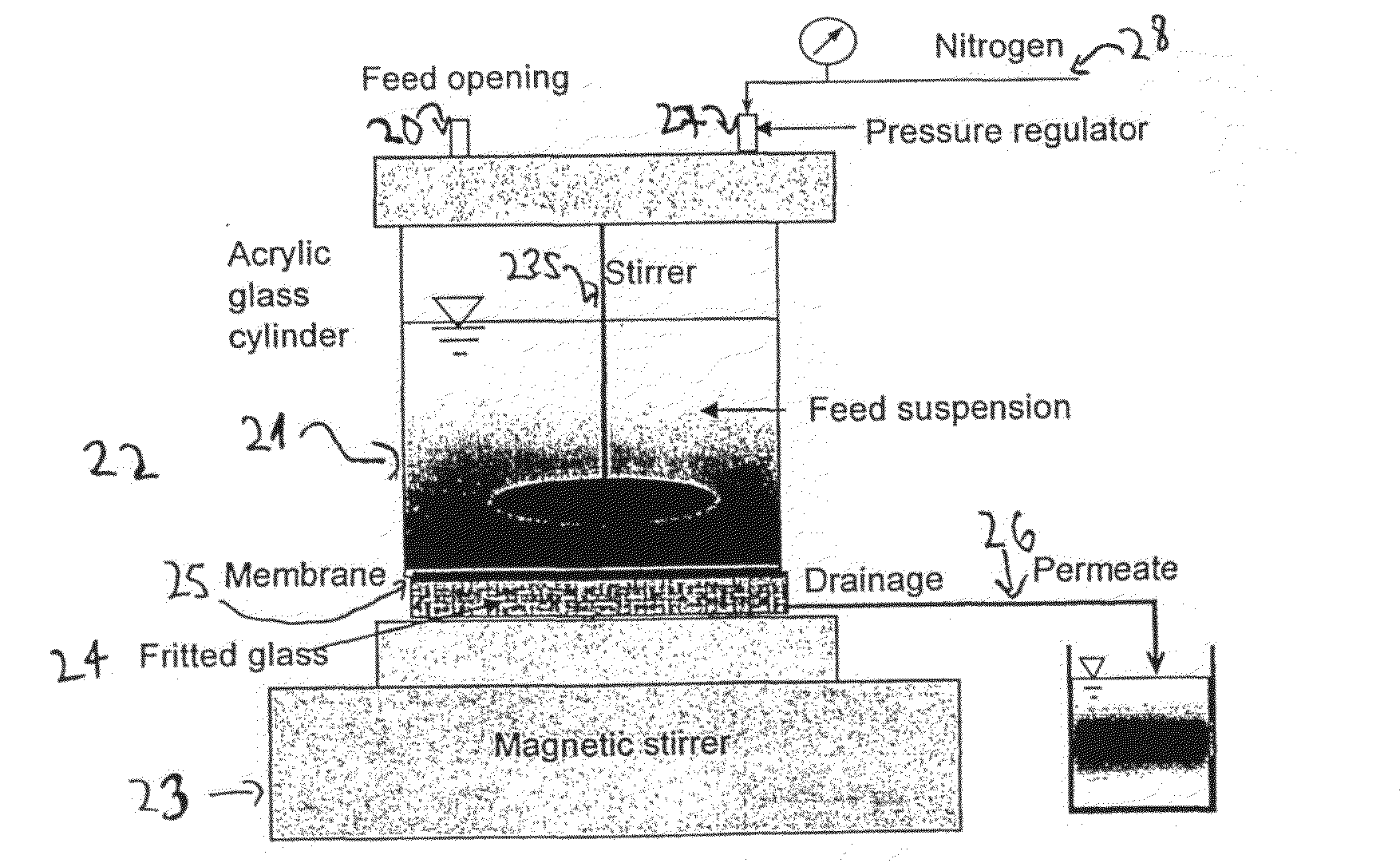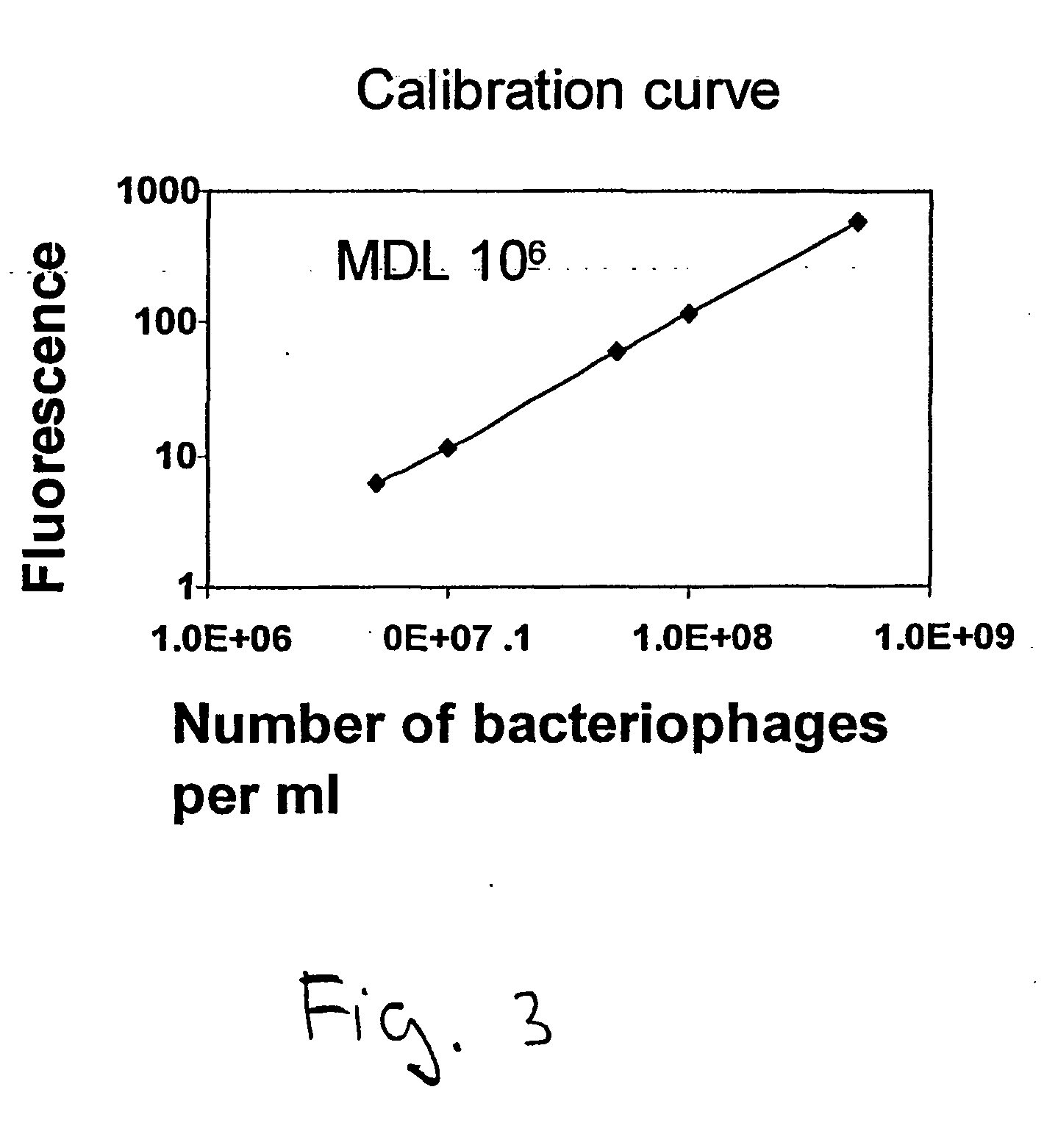Method for Testing the Integrity of Membranes
a filtration membrane and integrity technology, applied in the field of evaluating the integrity of filtration membranes, can solve the problems of preventing the full utilization of ultrafiltration (uf), microfiltration and nanofiltration technologies for water treatment, and accurately monitoring,
- Summary
- Abstract
- Description
- Claims
- Application Information
AI Technical Summary
Benefits of technology
Problems solved by technology
Method used
Image
Examples
example 1
Testing the Integrity of Intact Membranes by Means of MS2 Bacteriophages
Preparation
[0070]The initial stock of MS2 bacteriophages (DSM-No 13767) along with Escherichia coli host cells (DSM-No 5695) were purchased from German Collection of Microorganisms and Cell Cultures (DSMZ, Braunschweig, Germany). The bacteriophages were prepared by inoculation of 1:1 ratio of phages and host cells to the overlayer. After 24 hours incubation at 37° C., the overlayer containing the infected bacterial cells was scrapped into 50-ml tubes. Purification of the bacteriophage culture was accomplished by chloroform extraction. The stock was enumerated by plaque-assay method using the double-layer technique.
[0071]The initial titer was diluted to the concentration of 2×1011 PFU / ml and labeled with fluorescein-5-isothiocyanate, FITC, fluorescein, 5-(4,6-dichlorotriazinyl)aminofluorescein, 5-DTAF, or rhodamine B. For FITC and DTAF, 1.2 mL of MS2 phages in 0.1 M borate buffer, pH 9.2, were mixed with 0.021 g ...
example 2
Testing the Integrity of Intact Membranes by Means of T4 Bacteriophages
2A: Fluorescent Dye Labeling of T4 Bacteriophages
Preparation
[0074]Five ml of an initial solution containing 1010 (ten to the power of ten) T4 phages were washed by introducing them into a dialysis membrane bag, and then they were left overnight in one liter of 10 mM of HEPES buffer at 4° C., to give Solution A. Into 5 ml of Solution A were added 25 mg of commercial Sulfo-N-hydroxysuccinimidobiotine (EZ-link Sulfo-NHS-Biotin of Pierce, Rockford, Ill. USA) and the mixture was left to react for 24 hours at 4° C., to give Solution B.
[0075]250 microliter of solution B were mixed with 500 microliter of streptavidin-fluorescein conjugate (commercially available, from Amersham Biosciences UK limited, Amersham Place, Little Chalfont Buckinghamshire, England. Catalogue number RPN1232-2ML) and the resulting solution was left to react for 24 hours at 4° C. The obtained solution was washed for two days by introducing it into ...
example 3
Testing the Integrity of Intact Membranes by Means of Proteins
Preparation
[0091]Bovine serum albumin (cold alcohol precipitated BSA) was purchased from Sigma-Aldrich. Israel Ltd. (Rehovot, Israel). A 0.15-g sample was dissolved in 500 ml deionized water (RO quality) to form a 0.3 g / L protein solution. The solution was labeled with fluorescein-5-isothiocyanate, FITC, fluorescein, 5-(4,6-dichlorotriazinyl)aminofluorescein, 5-DTAF, or rhodamine B. Same procedure as in working Example 1 was used. The labeled protein mixture was purified by membrane dialysis (The Scientific Instrument Center Ltd., London, UK) under stirring.
The Test
[0092]Fifty ml of the obtained stock was withdrew from the storage and filtered through the membrane. Ten ml of the permeate were collected and analyzed with Perkin-Elmer LS-50B FL fluorescence spectrometer (Perkin Elmer, Norwalk, USA) equipped with a 1-cm optical path length cuvette. The obtained intensity of the sample was compared to the calibration curve ob...
PUM
| Property | Measurement | Unit |
|---|---|---|
| size distribution | aaaaa | aaaaa |
| size distribution | aaaaa | aaaaa |
| diameter | aaaaa | aaaaa |
Abstract
Description
Claims
Application Information
 Login to View More
Login to View More - R&D
- Intellectual Property
- Life Sciences
- Materials
- Tech Scout
- Unparalleled Data Quality
- Higher Quality Content
- 60% Fewer Hallucinations
Browse by: Latest US Patents, China's latest patents, Technical Efficacy Thesaurus, Application Domain, Technology Topic, Popular Technical Reports.
© 2025 PatSnap. All rights reserved.Legal|Privacy policy|Modern Slavery Act Transparency Statement|Sitemap|About US| Contact US: help@patsnap.com



